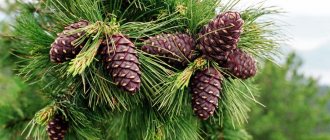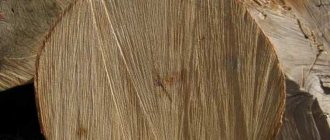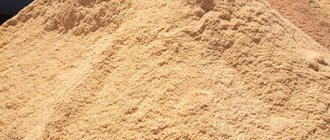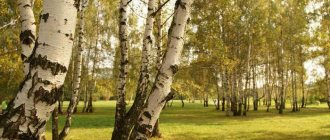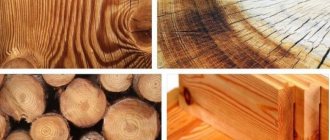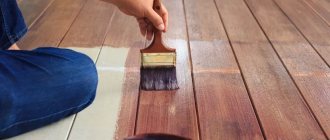Cedar wood is expensive, prestigious and beautiful. Largely due to the fact that this tree was mentioned in the Bible and expensive products have been made from it from time immemorial, cedar is often called any coniferous wood. The Mediterranean countries are considered the birthplace of this tree, whose height does not exceed 50 meters. In Russia, cedar of various types grows on the southern coast of Crimea, as well as in Siberia. In our country, its wood is used in construction, as well as in furniture production.
Description of cedar wood
Cedar pine, which is the second name for cedar, has a light core with a yellow or pink tint. It is practically no different from sapwood. The resin passages of cedar are smaller than those of pine. But at the same time they are more clearly expressed.
GOST 20022. 2-80 classifies cedar as a resistant species that very rarely rots. But at the same time, cedar wood is very soft and can be processed perfectly in all directions.
In Siberia, houses are still built from cedar. Moreover, as practice shows, they can last more than a hundred years.
They also make from cedar:
- pencils;
- plywood;
- veneer;
- furniture;
- racks for mining production;
- hives;
- musical instruments;
The life expectancy of cedar is quite high. So, it can exist up to 4 centuries. In the Baltics there is a long-lived cedar, which is 1,500 years old. Therefore, it is impossible to unequivocally answer the question of how many years a cedar tree lives.
It is worth mentioning the beneficial properties of cedar:
Canadian Cedar for Interior Works
Also, due to other unique attributes, such as: excellent color range, acoustic qualities and the same geometric stability, Canadian Red Cedar is used in various interior works:
- lining for baths, saunas and steam rooms in spa complexes
- finishing of walls and ceilings from various molding profiles, such as: calm lining, imitation timber, wall parquet and of course euro lining
- platband, plinth, corner, slats and a large assortment of joinery products for the interior
- doors, windows, door and window blocks and window sills
- turnkey saunas and steam baths
- finishing of pool rooms and arrangement of terraces around swimming pools, Jacuzzis, hot tubs and plunge pools
- musical instruments
This is not the entire list of useful products made from Canadian Red Cedar used in human life!! The use of Canadian Cedar in a smoking board when cooking fish, meat and vegetables on the grill, barbecue, barbecue, oven or charcoal gives an excellent effect. And for therapeutic and preventive purposes, we recommend the “Health Screen”, which allows you to use the property of Canadian Cedar to release phytoncides beneficial to the human body.
If you want to know more about this amazing species of coniferous tree, read on...
One of the most gigantic trees in the world: Thuja Plicata
Canadian Red Cedar Western Red Cedar - Western Red Cedar Thuja Plicata - (Lat.) Thuja Plicata (Lat.)
Varieties
In total, 2 types of cedar form 9 subspecies. All trees do not grow very quickly, but their wood is very valuable, largely due to the fact that it is resistant to decay. It is surprising that cedar grows in Asia, Africa, Siberia, Crimea, and Transcaucasia. It is believed that this tree is heat-loving. Nevertheless, Siberian cedar tolerates harsh winters well.
Siberian
Some experts still claim that there is no Siberian cedar, there is pine, which is similar to cedar. Therefore, this tree is classified as a pine species. However, Siberian pine pine is a frost-resistant evergreen tree.
It grows successfully in the Moscow region, Leningrad and Voronezh regions, as well as throughout Siberia, Altai (Altai) and the Urals. The lifespan of a tree reaches 800 years. In size, Siberian cedar is second only to sequoia. The diameter of its trunk reaches 2 meters.
The growing season of cedar is only 45 days; the rest of the time the tree remains dormant. The most valuable product of cedar is its nuts. They are rich in vitamins, healthy fats and minerals. Nuts are eaten raw and oil is made from them. Siberian cedar is a very beautiful tree, valuable to humans.
Photo of Siberian cedar
Siberian cedar
Siberian cedar cones
Lebanese
An evergreen coniferous tree with a trunk up to 2.5 meters. This cedar grows slowly. It can withstand temperatures down to -30°C. Its bark is dark gray with small scales. This type of cedar is a symbol of Lebanon, where it comes from. It feels best at an altitude of 1,000 to 2,000 meters above sea level. In Russia, Lebanese cedar grows on the Black Sea coast.
Cedar propagates by seeds. In youth it has a conical crown, in old age it has the shape of an umbrella. The cones are shaped like a barrel. By the way, earlier essential oils were obtained from pine needles, but now from Lebanese cedar wood. This tree is depicted on the state symbols of Lebanon. And Lebanese cedar is often mistakenly called Libyan.
Photo of Lebanese cedar
Lebanese cedar cones
Lebanese cedar
Canadian
The oldest Canadian red cedar grows in Washington's Olympic Park. Its age is 1,200 years. An ordinary Canadian cedar reaches a height of 75 meters, and the diameter of its trunk can be up to 6.5 meters. The tree has very soft, pliable wood.
Despite its name, Canadian red cedar has wood that ranges in color from light beige to brownish-red. When heated, Canadian cedar wood does not release resin. The wood does not crack during processing.
Photo of Canadian cedar tree
Himalayan
This cedar grows up to 50 meters, the maximum width of its trunk is no more than 3 meters. Its needles are soft and light green in color. It lives up to 1,000 years, but under favorable conditions it can live up to 3,000. The cones ripen within a year and a half. Himalayan cedar tolerates darkness well.
The cedar crown is conical, but very wide. It loves high humidity, including soil, so it feels great in the conditions of the southern coast of Crimea. Although this species is frost-resistant, which means it may well exist in the conditions of central Russia.
Photo of Himalayan cedar
Deodar
Himalayan cedar cones
Far Eastern
This is the most frost-resistant cedar. Its lifespan reaches 600 years. Far Eastern cedar grows in a mixed forest. Next to him there is always a linden, birch, and fir tree. Its cones, like those of the Siberian cedar, have edible nuts. The cedar begins to bear fruit after its twentieth birthday.
The tree respects moderate watering and dry soil. Where Far Eastern cedars grow, there are always healthy trees and shrubs, and the air is fresh and even healing. Turpentine and rosin are obtained from cedar resin.
Photo of Far Eastern cedar
European
Scientists classify the tree as a member of the pine family. This cedar likes to grow on south-facing slopes at altitudes of 1,500 to 2,500 meters above sea level in Central Europe and Russia. The maximum tree height is 25 meters. European cedar is very similar to Siberian pine. Only its growth is lower and the trunk is thinner, and the bark is more beautiful and stronger.
And this is what a European cedar tree with cones looks like in the photo
Korean
The tree can grow up to 40 - 50 meters with a trunk diameter of up to 1.5 meters. Scientists also classify this species as a pine tree. The bark has a reddish tint, in youth it is gray, and in more mature age it is brown. Young cedar has large cones of red color with a purple tint, but there are few of them. The old one has many times more, but the size is small.
The tree grows in Korea and the adjacent Russian territory. Korean cedar is a monoecious tree. Male spikelets are yellow. But the needles are bluish-green.
Photo of Korean cedar
In construction
The active use of wood is observed in construction. The material is imported to Russia from Canada, so its cost is high, but it is justified by its quality and durability. The wood is used to build yachts, create exclusive designer furniture, luxury housing and offices.
Houses
Canadian cedar occupies a leading position in the line of environmentally friendly materials. It is in high demand among developers. Wood is used to make beams for assembling walls, assembling frame structures for internal floors, and making trusses for roofs. They are cut into veneer for laminating floors in residential and office premises, building flights of stairs, and used for wall finishing. Refractory material does not require additional processing.
The significant length of the logs compared to pine or spruce makes it possible to obtain building material for walls without frequent joining fragments and recuts. Houses made of Canadian cedar last for centuries and retain the subtle smell of resin for a long time. The logs are split into shingles for roofs.
Cedar log houses are especially popular
Baths and saunas
The chopped bathhouse on the site is a symbol of Russian national culture. It has not so much a hygienic function as an aesthetic one: it gives the territory a special flavor. Canadian cedar for a bathhouse is an irreplaceable material, but expensive. The structure will serve in its original form for more than one generation.
The wood of wild-growing folded thuja is used for timber frames and for finishing the interior
Facts in favor of decorating a bathhouse and sauna room made of red cedar:
- Walls lined with clapboard or cedar profiles heat up much faster than materials made from other conifers. Cedar boards have high thermal insulation.
- The structure of the material does not absorb, but repels moisture, so the lining does not rot or mold.
- Wood products do not deform due to sudden temperature changes during operation.
- The heating of the surface is insignificant and does not burn the skin even at high temperatures in the steam room.
- The texture of boards made of Canadian cedar wood looks aesthetically pleasing when assembled; the surface after processing is very smooth and does not require additional coating.
- Walls made of Canadian cedar are characterized by a pleasant pine aroma, which intensifies when heated. Such a sauna or bathhouse is useful for people with respiratory diseases.
- The resin content in wood is high, but the structure of the fibers keeps them inside, so they do not release to the surface.
When assembling panels or lining from Canadian cedar, it is not recommended to use iron fasteners, especially in the steam room, since the metal gets very hot
For finishing
For finishing work, three types of Canadian wood materials are used:
- eurolining that meets European quality standards, with deep grooves for fitting panels;
- extra, with a smooth surface without cracks, knots or other defects;
- calm, designed for uniform cladding without gaps at the joint.
The surface is covered with oil wax; it preserves the natural texture and aroma of pine needles. Colorless varnishes are used, which increase the service life of the material. For more demanding consumers, brushing is carried out, giving the cladding a bohemian look due to artificial aging.
Finish options:
- Cover the walls of the living rooms.
- The hallway ceilings are decorated and fireplaces are decorated.
- Decorate the room for relaxation.
- Used for the production of decorative stair balusters and railings.
- They use Canadian cedar panels to decorate the bathroom,
- Summer verandas are being decorated.
In other areas
Areas of use of Canadian red cedar:
- in carpentry: for the manufacture of furniture, trim, doors, windows, balconies, window sills, fonts;
- in landscape design for the construction of gazebos, pergolas, terraces;
- used in the construction of yachts for finishing cabins, decks, bar counters;
- produce musical instruments.
In elite neighborhoods, children's playgrounds and fences around them are built from Canadian red cedar.
Physical properties of cedar wood
Cedar is a core tree species. It resembles pine in texture, but has more pronounced lines. The physical properties of cedar allow the tree to be classified as elite and therefore all products made from its wood have a high price.
Density
The higher the humidity, the higher the density of the wood. The density of cedar in a completely dried state is 410 kg/m3. At a standard humidity of 12%, the density is 435 kg/m3, and the conditional density (the ratio of the mass of absolutely dry wood to the mass of the same volume of wood at the hygroscopicity stage) does not exceed 350 kg/m3.
Strength
Such an indicator as the strength of each wood is standard, and its increase or decrease depends on the humidity of the environment and the defects of the tree.
The tensile strength of cedar can be as follows:
- Compression along the fibers ranges from 33 to 40.6 MPa.
- Static bending - 54.1 to 79.9 MPa.
- Tension along the fibers is 90.2 MPa.
- Chip along the fibers - 5.64 - 6.39 MPa.
- Along the radial or tangential plane it ranges from 5.64 to 7.15 MPa.
For different types of cedar, these indicators differ slightly from each other and, in general, only Altai cedar has higher figures for physical and mechanical parameters.
Humidity
In a freshly felled cedar, the humidity exceeds 100%, and with maximum water absorption it can double and reach 220%. The humidity of absolutely dry cedar is 420%. A distinctive feature of any type of cedar is that it is not afraid of moisture and therefore can be used where the humidity is quite high.
Cedar wood weight
The structure of the cellular tissue, as well as its quantity in its pure form, plus the water level and the content of organic and inorganic substances, are responsible for the weight of the wood. Roots weigh the least, branches and twigs weigh more. The specific gravity of wood always depends on the type of tree. And these average figures for cedar vary in different reference books from 360 to 570 kg/m3.
The generally accepted indicators of the volumetric weight of 1 m3 of cedar are as follows:
| Humidity indicator, % | Weight, kg |
| 12 | 450 |
| 18 | 500 |
| 23 | 550 |
| natural moisture of freshly cut cedar | 800 |
Where Is Canadian Red Cedar Used?
Initially, Canadian Cedar was used by cabinetmakers. Famous craftsmen used wood to decorate living rooms, make furniture and musical instruments. Today, the scope of its application has expanded significantly. Canadian Red Cedar has gained particular popularity in the world as a material for the construction of luxury log cottages, any decoration of houses, saunas, baths, swimming pools, and so on. The scope of application of Red Cedar is very significant. The material is also used for the manufacture of roofing (shingles and shingles), facades, terraces, gazebos, fences, any garden furniture, finishing yachts and offices, arranging wine cellars, making interior items, boxes for storing cigars, etc.
Canadian Red Cedar is a unique, environmentally friendly, durable material for construction and decoration that will create an amazing microclimate in any room. This material is suitable for those people who value comfort and love luxury.
- Buy sauna lining from Canadian Red Cedar
- Buy Canadian Red Cedar
Canadian red cedar in all its glory!
There is no substitute...for real Canadian Red Cedar...in nature!!!
Chemical composition
Cedar phytoncides disinfect the air, while its needles contain a lot of vitamin C and provitamin A. The cedar kernel contains 17% protein; 12% starch; 4% fiber; up to 20% carbohydrates; at least 60% oils. Wood contains organic acids, hydrocarbons, stilbenes, and flavonoids. In aromatherapy, cedar oils have a special place. Assessment of the chemical characteristics of wood 5.
Color and texture
All types of cedar wood are very similar in color. They have a light core with a brown or yellow tint. The wood has a pronounced cedar aroma and an oily surface. The contrast between the early and late zones is clearly visible.
The grain of cedar wood is medium in size. Middle-aged cedar has straight grain. Himalayan cedar has brown lines on a longitudinal section. The appearance of cedar wood has distinctive features that make it extremely interesting and beautiful.
An example of cedar wood texture
Sap
Resin is the resin of a plant, which is extracted during active sap flow. Known for its powerful antibacterial and wound-healing properties, it creates a natural barrier to viruses, fungi, and microbes. The composition of resin is unique and contains:
- resin components – resinols, ether resins, resinous compounds;
- volatile carbohydrates monoterpenes - phellandrene, pinene, camphrene, limonene, used for the production of turpentine;
- sesquiterpenes, diterpenes - neutral components, the basis of the resinous secretions of the plant;
- higher fatty acids, including linoleic acid.
Cedar resin restores, heals, is considered a natural immunomodulator, and relieves neuroses and depression. Resin is actively used in aromatherapy for the common cold, flu, acute respiratory infections, to facilitate the removal of sputum, and improve respiratory function. Cedar essential oil is used with aroma lamps, aroma pendants, and added to inhalers for a speedy recovery from colds.
Its properties and power of influence are extensive. Resin based products are considered:
- antioxidants that normalize metabolism, remove toxins, carcinogens, waste;
- anti-ulcers, normalizing microflora and activity of the gastrointestinal tract;
- anti-sclerotic, activating brain activity;
- wound-healing, removing inflammation, swelling, quickly relieving any abscesses, wounds, acne, any problems of the epidermis.
Cedar resin is effective when the following problems occur:
- blindness, glaucoma, intraocular pressure, any eye diseases;
- inflammatory processes of any etiology, duration;
- diseases of the oral cavity, including periodontal disease, stomatitis, caries;
- muscle spasms, joint pain;
- loss of strength, anemia, weakened immunity after surgery, illness;
- thrombosis, arrhythmia, atherosclerosis, angina pectoris, other vascular and heart problems;
- gastrointestinal diseases: stomach and intestinal ulcers, gastritis, inflammation, obstruction of the bile ducts;
- bone fractures, chronic, severe damage to soft and hard tissues, up to gangrene;
- prevention, treatment of cancer of various origins and duration.
Mechanical properties of cedar wood
According to its physical and mechanical properties, cedar wood occupies a place between fir and spruce. Although it is more resistant to the processes of suppuration. Although soft, cedar wood is at the same time very durable.
Hardness
The hardness of the side surface of cedar is 40% lower than the end surface. According to the Brinell scale, this wood is classified as soft and its hardness is 4 HB. Although its strength is rated quite highly.
Due to its softness but strength in carpentry, cedar wood is used to make products that will be subject to significant loads in the future. The cedar is rated 5 for these properties.
Combustion temperature and calorific value of cedar
Cedar does not make the best firewood. They don't produce much heat, and their resinous nature can also ruin the chimney. But at the same time, cedar firewood takes a very long time to smolder. Although they have a low calorific value and its indicator is 4.3 kW/hour.
In terms of flammability, cedar belongs to the category of unstable wood. The fire resistance index does not exceed 1.1 - 1.5. The specific calorific value of cedar is close to that of pine. The more moisture there is in the wood, the harder it burns. The average calorific value of cedar, which has been dried as much as possible, can be from 4907 to 4952 calories.
This means that the energy released during the combustion of one kilogram of cedar firewood is enough to heat 4 tons of water by 1°C. GOST 3243-88 classifies cedar as the third group of firewood with low calorific value. This also includes poplar, willow, linden, fir, and pine.
Ash content
The ash content of biomass depends on what part of the wood is burned. So, in a dry cedar trunk there is from 0.2 to 0.7% ash. In the bark it is already 1.4%, and in branches and roots it can be even up to 2%. But most of the ash is formed during the combustion of bark - up to 2.2%.
Cedar is a beautiful, powerful tree that, while growing, heals other trees and the air around it. And as wood it brings invaluable benefits to humans and is used by them practically without a trace. Rating of wood, taking into account its appearance and all characteristics 5.
Characteristics of Canadian Red Cedar
Due to the main characteristics of Canadian Red Cedar - durability, excellent aroma, natural resistance to rot and insects, geometric stability and high insulating ability... its scope of application is very significant.
For exterior use, Canadian red cedar is used in:
- construction of houses (log or timber)
- production of wooden roofing tiles - shingles and shingles
- cladding and production of facades of houses, cottages and commercial buildings
- installation of outdoor terraces, gazebos, fences and fence posts, playgrounds, greenhouses/greenhouses and any garden furniture
- construction and finishing of expensive yachts
Kernels (seeds)
The nuts of an evergreen tree are a depot of useful microelements and vitamins; they are useful for adults, children, and women during pregnancy and lactation. Cedar seeds are healthy and high in calories, 100 g contains 673 Kcal. Contents of useful elements:
- 65-70% natural oil, completely absorbed by the body;
- carbohydrates, proteins, 19% nitrogen compounds;
- 4% fiber, 2% ash, pentosans;
- amino acids, minerals;
- potassium, sodium, cobalt, iodine;
- manganese, phosphorus, potassium, molybdenum;
- iron, copper, zinc;
- lecithin, vitamin complex.
What are the benefits of cedar kernels? They are considered to be a depot of nutrients beneficial to the body. Regular use improves the composition and quality of blood, stimulates the functions of the thyroid gland, normalizes the functioning of internal organs and endocrine glands. They have a beneficial effect on the heart muscle, increase elasticity and strength of blood vessels, and strengthen the immune system. Nuts are good for children, teenagers, and adults; they promote quick satiety, normalize metabolism, and have a beneficial effect on the intestinal microflora and digestive system.
- relieve symptoms and the course of colds, help with vitamin deficiency, loss of strength;
- strengthen joints, ligaments, connective and bone tissues, regulate the processes of salt deposition;
- activate regeneration processes, promote rapid healing of ulcers and wounds;
- will help with hormonal imbalance, uterine bleeding, menstrual irregularities, impotence;
- ease the course of allergies, asthma, have a beneficial effect on the body in case of anemia, diabetes;
- improve the functioning of the organs of vision, will be a good prevention and treatment for ailments of the hearing aid;
- improve the condition of the nervous system, have a calming, relaxing effect, and help normalize sleep.
The milk of cedar kernels is an indispensable medicine for tuberculosis and genitourinary diseases. You can use it to make butter that tastes just like butter, but has great nutritional value.
